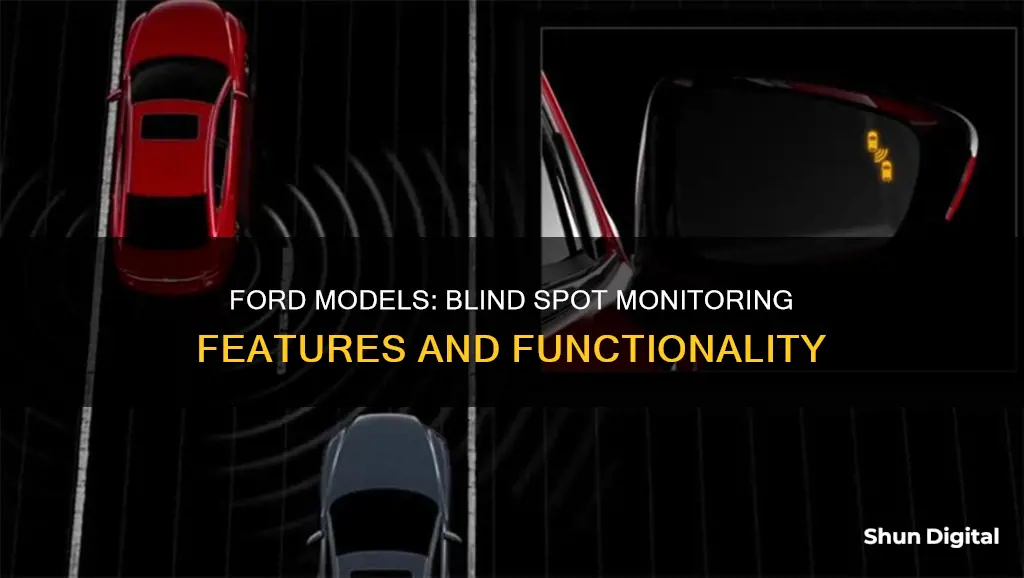
Blind-spot monitoring is a vehicle-based sensor device that detects other vehicles located in a driver's blind spot. Ford's system is called BLIS (Blind Spot Information System), which uses radar sensors to monitor the rear and sides of the vehicle. BLIS is part of the Ford Co-Pilot360™ suite of safety features and is available in several new and used sedans, SUVs, and pickup trucks. Here are some Ford models that commonly come equipped with BLIS:
- 2023 Ford Mustang
- 2023 Ford Bronco Sport
- 2023 Ford Bronco
- 2023 Ford Edge
- 2023 Ford Escape
- 2023 Ford Explorer
- 2024 Ford Expedition
- 2023 Ford Maverick
- 2023 Ford Ranger
- 2023 Ford F-150
- 2023 Ford Super Duty, including the F250 and F350
- 2023 Ford Transit Connect
- 2023 Ford Transit
- 2023 Ford F-150 Lightning®
- 2023 Ford Mustang Mach-E®
| Characteristics | Values |
|---|---|
| Name of the System | BLIS® (Blind Spot Information System) |
| How it Works | Radar sensors on both sides near the rear of the vehicle detect other vehicles in the blind spot. |
| Alerts | Visual (indicator light in the side-view mirror), audible, vibrating, or tactile |
| Availability | Standard on all new Ford vehicles as part of the Co-Pilot360™ technology suite |
| Models | 2023 Ford Mustang, Bronco Sport, Bronco, Edge, Escape, Explorer, 2024 Expedition, Maverick, Ranger, F-150, Super Duty, Transit Connect, Transit, F-150 Lightning®, Mustang Mach-E® |
What You'll Learn

How does blind spot monitoring work?
Blind-spot monitoring is a safety feature that uses sensors on the outside of a car to monitor the driver's blind spots and alert them if they are attempting to make an unsafe lane change. The alerts are usually visual, audible, or tactile, with lights and beeps to help prevent accidents.
Blind-spot monitoring systems use sensors, usually radar or ultrasonic, on the sides and rear of the vehicle to detect when a car enters the driver's blind spot. If a vehicle is detected, the system will alert the driver with a notification light on or near the side mirror on the appropriate side of the vehicle. Some systems also provide an audible alert, such as a beep or tone, to draw the driver's attention to the potential hazard. More advanced systems may also provide a vibrating or tactile alert, such as a seat that vibrates.
If the driver activates their turn signal while the blind-spot monitoring system is triggered, the system will typically provide an audible alert to warn the driver of the potential hazard before changing lanes. This alert can help prevent lane-change crashes and reduce the risk of accidents and injuries.
In addition to the basic functionality of blind-spot monitoring, some systems offer more advanced features. For example, Lane Change Assist, as Hyundai calls it, extends the range of the side sensors to three to five car lengths back and monitors the speed of oncoming vehicles. This allows the system to predict when a vehicle will enter the driver's blind spot and provide an early warning.
Blind-spot monitoring is a convenient feature that can enhance safety and reduce stress while driving, but it is not a replacement for proper mirror adjustment, turning your head to check blind spots, and staying alert while driving. It is important for drivers to understand the limitations of blind-spot monitoring systems and continue to practice safe driving habits.
Ford was one of the first companies to incorporate blind-spot monitoring into its vehicles, adapting the system from its previous parent company, Volvo. Ford uses the acronym BLIS (Blind Spot Information System) for its blind-spot detection system, which is active in "drive" and "neutral" transmission gears. The system was first introduced in 2009 on several Ford and Lincoln models, including the 2010 Ford Fusion and Fusion Hybrid, and the 2010 Lincoln MKZ.
Finding a Timor Monitor: A Comprehensive Guide
You may want to see also

Which Ford models have blind spot monitoring?
Blind Spot Information System, or BLIS®, is Ford's blind spot warning system. It is part of the Ford Co-Pilot 360™ suite of safety features in several new and used sedans, SUVs, and pickup trucks. BLIS® uses radar sensors to monitor the rear and sides of the vehicle to detect other vehicles and alerts the driver with a warning light in the side-view mirrors if there is something there.
BLIS® with Cross-Traffic Alert can detect traffic behind the vehicle while reversing out of a parking space or driveway. When a vehicle is detected in the blind spot, the driver is alerted with an indicator light in the side-view mirror. A visual display in the message centre indicates the direction from which the vehicle is coming.
Blind Spot Information System with Rear Cross-Traffic Alert is a standard feature on all new Ford vehicles. Here are some Ford models that commonly come equipped with blind-spot monitors:
- 2023 Ford Mustang
- 2023 Ford Bronco Sport
- 2023 Ford Bronco
- 2023 Ford Edge
- 2023 Ford Escape
- 2023 Ford Explorer
- 2024 Ford Expedition
- 2023 Ford Maverick
- 2023 Ford Ranger
- 2023 Ford F-150
- 2023 Ford Super Duty, including the F250 and F350
- 2023 Ford Transit Connect
- 2023 Ford Transit
- 2023 Ford F-150 Lightning®
- 2023 Ford Mustang Mach-E®
- 2024 Mustang Mach-E®
- 2024 F-150 Lightning®
It's important to note that certain trims and packages may offer blind spot monitoring as an optional feature only.
Chevy Equinox: Blind Spot Monitoring Feature Explained
You may want to see also

How does Ford's blind spot monitoring compare to competitors?
Ford's Blind Spot Information System (BLIS) is a system of protection developed initially by Volvo. Ford Motor Company has since adapted the system to its Ford, Lincoln, and Mercury brands. The system uses radar sensors on both sides near the rear of the vehicle to detect other vehicles located in the driver's blind spot. When a vehicle is detected, the driver is alerted with an indicator light in the side-view mirror, an audible warning, and a visual display in the message centre indicating the direction of the approaching vehicle.
Ford's system is similar to those offered by other car manufacturers. For example, Mazda was the first Japanese automaker to offer a blind spot monitor, which they refer to as "BSM" (Blind Spot Monitoring). It was initially introduced on the 2008 Mazda CX-9 Grand Touring and has since been expanded to other models, including the Mazda2, Mazda3, CX-3, and CX-5. Like Ford's system, Mazda's BSM uses sensors to detect vehicles in the driver's blind spot and provides visual and audible alerts.
Another example is Mitsubishi, which offers a Blind Spot Warning (BSW) on the Pajero Sport. This system also uses sensors to detect vehicles in the driver's blind spot and provides visual and audible alerts.
Nissan offers a unique feature called "blind spot intervention" on its Fuga/Infiniti M models. This system not only detects vehicles in the driver's blind spot but also offers countersteering capabilities to prevent collisions actively.
Overall, Ford's blind spot monitoring system is comparable to those offered by other car manufacturers. While the basic functionality of detecting vehicles in the driver's blind spot and providing alerts is standard across the industry, some manufacturers, like Nissan, offer more advanced features that actively intervene to prevent collisions.
Buy Sleep Oxygen Desaturation Monitors: Top Places to Consider
You may want to see also

What are the pros and cons of blind spot monitoring?
Blind-spot monitoring is a vehicle-based sensor device that detects other vehicles located in a driver's blind spot. It is designed to alert the driver that someone is approaching in the next lane. This technology typically uses a pair of sensors situated on the side mirrors or the rear bumper to detect vehicles in adjacent lanes. If the system detects a moving vehicle, it will alert the driver via an audible, visual, vibrating, or tactile warning.
Pros of Blind Spot Monitoring:
- Increases driving awareness by providing extra coverage.
- Assists drivers of larger vehicles, reducing stress by monitoring areas that are hard to see.
- Can prevent crashes by alerting drivers to potential hazards.
- Increases response time by alerting drivers to potential dangers faster.
- Reduces the risk of merging into another vehicle.
- Provides comprehensive protection from side and rear collisions.
- Can be bundled with a rear cross-traffic alert feature, which detects vehicles, objects, or pedestrians when reversing out of parking spots.
Cons of Blind Spot Monitoring:
- Blind-spot monitoring systems may struggle to detect fast-moving vehicles, providing alerts too late for the driver to take action.
- Systems that rely on visual cues may be ineffective in certain circumstances, such as when a driver is affected by bright lights.
- Some systems only provide audio cues when the turn signal is activated, which may be insufficient for effective warning.
- The system is not 100% reliable and may give false alarms in certain situations, such as when a vehicle is passing through a tunnel wall.
Mumbai's Best Monitor Retailers: A Comprehensive Guide
You may want to see also

How do I get blind spot monitoring in my Ford?
Blind Spot Monitoring is a vehicle-based sensor device that detects other vehicles located in a driver's blind spot, in the rear, or on either side of the vehicle. Ford's system is called BLIS (Blind Spot Information System) and it uses radar sensors to monitor the rear and sides of the vehicle. When a vehicle is detected in the blind spot, the driver is alerted with a warning light in the side-view mirrors. BLIS also includes Cross-Traffic Alert, which can detect traffic when reversing out of a parking space or driveway.
Blind Spot Monitoring is available in the following Ford models:
- 2023 Ford Mustang
- 2023 Ford Bronco Sport
- 2023 Ford Bronco
- 2023 Ford Edge
- 2023 Ford Escape
- 2023 Ford Explorer
- 2024 Ford Expedition
- 2023 Ford Maverick
- 2023 Ford Ranger
- 2023 Ford F-150
- 2023 Ford Super Duty, including the F250 and F350
- 2023 Ford Transit Connect
- 2023 Ford Transit
- 2023 Ford F-150 Lightning
- 2023 Ford Mustang Mach-E
- 2024 Mustang Mach-E
- 2024 F-150 Lightning
If you want to add blind spot monitoring to an older Ford model, you can consider installing an aftermarket blind spot monitor. This involves placing sensors on the rear bumper of your car, which will trigger an indicator when another vehicle is detected. You can install an aftermarket blind spot monitor yourself, but professional installation is recommended.
Monitoring Data Usage: Control Your Router's Data Consumption
You may want to see also
Frequently asked questions
Many Ford models offer blind-spot monitoring, including the 2023 Ford Mustang, the 2023 Ford Bronco Sport, the 2023 Ford Edge, the 2023 Ford Escape, the 2023 Ford Explorer, the 2024 Ford Expedition, the 2023 Ford Maverick, the 2023 Ford Ranger, the 2023 Ford F-150, the 2023 Ford Super Duty, the 2023 Ford Transit Connect, the 2023 Ford Transit, the 2023 Ford F-150 Lightning, and the 2023 Ford Mustang Mach-E.
Blind spot monitoring is a vehicle-based sensor device that detects other vehicles located to the driver's side and rear. It provides an audible and/or visual warning to the driver.
Ford's system is called BLIS® (Blind Spot Information System). It uses radar sensors that monitor the rear and sides of the vehicle to detect other vehicles and alerts the driver with a warning light in the side-view mirrors.
Blind-spot monitoring systems provide visual and/or audible warnings of vehicles or traffic in the blind spot areas. Blind spot assist systems work in combination with the radar sensors and the vehicle's other advanced driver assistance systems, and can provide some steering assist to keep the vehicle centred in the lane.
A blind spot monitor offers drivers increased awareness, reduced risk of collision, and increased confidence when driving, especially on highways and in congested traffic conditions.







